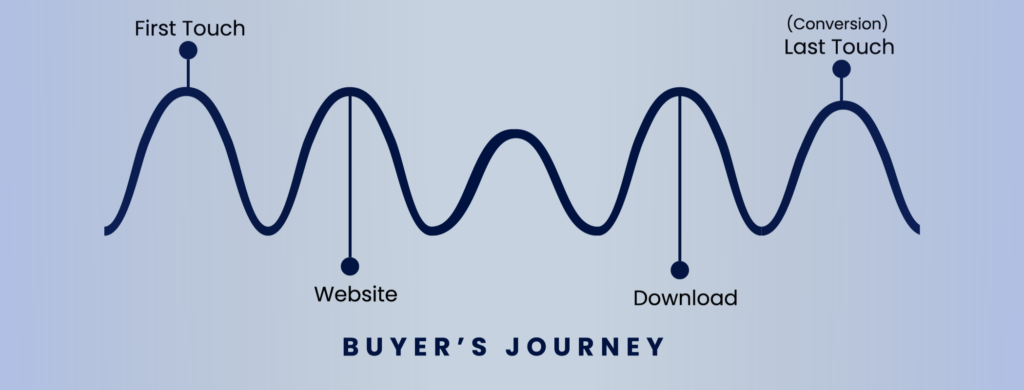B2B marketing attribution focuses on monitoring and evaluating key marketing touchpoints that drive leads toward becoming valued customers. This process involves assigning conversion credits to each marketing interaction across the customer journey, offering a roadmap to evaluate the effectiveness of various marketing channels and campaigns. Think of it as connecting the dots to understand better how marketing efforts impact conversions.
Attribution in the B2B space is more than a buzzword; it is transformative. It’s a data driven marketing tool that enables organizations to uncover the effectiveness of each marketing channel and strategy, leading to optimized marketing investments, enhanced customer journeys, and increased revenue. By accurately attributing conversion credits throughout the customer journey, businesses gain valuable insights into what strategies work best and where adjustments are needed. This insight drives informed decision-making, guiding businesses toward more strategic resource allocation and impactful marketing strategies.
3 Benefits of Leveraging Marketing Attribution
- Understand which efforts are making the most significant impact—how customers found you, what pages they visited, and touchpoints throughout their journey.
- Connect marketing dollar spends to closed deals: What channels and campaigns should receive credit for closed deals?
- Track organic and paid search investments and understand which organic and paid keywords generate deals and opportunities.
Real-World Example of Marketing Attribution
In the recent update of Google Analytics, GA 4, Google Ads now only offers last-touch and data driven attribution models. This means that Google will assign the conversion credit to the last-clicked ad or distribute credit to multiple touchpoints throughout the buyer’s journey. To understand more about the GA 4 update, click here. Keep reading to learn more about other attribution models and how to decide which one is best for you and your goals.
Common Attribution Models
In B2B marketing attribution, tracking and analyzing marketing touchpoints helps convert leads into customers. This process involves assigning credits to different interactions based on their impact on conversions, allowing businesses to understand channel effectiveness. Using attribution models like first-touch, last-touch, or multi-touch provides insights into the customer journey, optimizing spend, improving the experience, and driving revenue growth.
Some common attribution models include:
First-Touch Attribution
Full credit is given to a customer’s first interaction with a business before conversion.

Last-Touch Attribution
Attributes all credit to the final touchpoint before a conversion occurs.

Linear Attribution
Distributes credit equally across all touchpoints in the customer journey.

Time Decay Attribution
This gives more credit to touchpoints closer to the conversion event, diminishing the value of earlier interactions.

Position Based Attribution
Assigns credit to both the first and last touchpoints and some credit to intermediate interactions.

Data Driven Attribution
Considers and assigns credit to multiple touchpoints throughout the customer journey, providing a more comprehensive view of the conversion path.

Selecting the Right Model for Your Organization
When selecting the right attribution model for your efforts, consider your business objectives, customer journey, data availability, and analytical capabilities. Many organizations find that combining approaches may be needed to get the most accurate and actionable insights.
- Define your organization’s goals and objectives.
- Analyze your customer journey and touchpoints.
- Factor in your industry and product types.
- Reference historical data.
- Test different models.
- Understand your available resources.
- Have organizational buy-in.
While deciding which marketing attribution model is best for you may feel overwhelming, Endeavor Business Media’s Marketing Solutions team specializes in data driven marketing. Endeavor helps marketers optimize marketing spending using data driven strategies that eliminate budget waste and improve spend attribution. Ensuring marketers can navigate landscapes with precision and purpose by understanding attribution models, harnessing data driven insights, and aligning strategies with business objectives.
If you enjoyed this content and want marketing know-how delivered straight to your inbox, you’ll love our Marketing Minds newsletter. Sign up here!


![[Free Guide] 7 B2B Targeting Strategies to Reach High-Value Buyers More Effectively](https://marketingsolutions.endeavorb2b.com/wp-content/uploads/2025/05/Blog-photos-1-400x250.jpg)
![[Webinar] How to Stay Ahead in Automotive Marketing: Key Trends and Strategies for 2025](https://marketingsolutions.endeavorb2b.com/wp-content/uploads/2025/05/IMR-Webinar-400x250.png)
